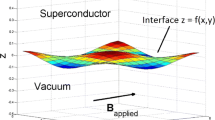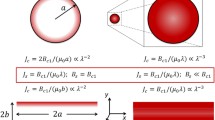Abstract
One of the defining characteristics of a superconductor is the Meissner effect, in which an external magnetic field is expelled from the bulk of a sample when cooled below the critical temperature. Although there has been considerable theoretical work on the Ginzburg–Landau theory of superconductors, the effects of interest in this paper can be modelled with the simpler London equation. This equation predicts an exponential decay of the local magnetic field magnitude as a function of the distance into the superconductor from a flat surface in the London limit where \(\kappa =\lambda /\xi \), defined as the ratio between the penetration depth and coherence length, is much greater than 1. However, recent measurements of the field profile in high \(\kappa \) superconductors show that the observed decay is non-exponential near the surface. In particular, the measured field profiles indicate that the decay rate in the field magnitude is smaller than expected from a simple London model on a short length scale \(d\) near the surface. In this paper, we examine the effects of surface roughness on magnetic field penetration into a high \(\kappa \) superconductor. We model the roughness as a sinusoidal perturbation from a flat interface and investigate the effect using both an asymptotic method, based upon a small-amplitude perturbation, and a numerical method, using a finite difference discretization with a coordinate mapping from an underlying rectangular domain. A novel discretization is used in the case of 3D calculations and a fast, preconditioned GMRES solver is developed. A careful comparison of asymptotic and numerical methods validates both approaches for small perturbations, but the numerical approach allows for the investigation of rougher surfaces. Our results show that surface roughness reduces the decay rate in the average magnetic field near the surface relative to a London model. However, the reduction is more gradual than the simple dead layer model currently being used to fit experimental data. In addition, we discover some interesting new phenomena in the 3D case.














Similar content being viewed by others
References
Poole C, Farach H, Creswick J (1995) Superconductivity. Academic Press, San Diego
Jackson T, Riseman T, Forgan E, Glückler H, Prokscha T, Morenzoni E, Pleines M, Niedermayer Ch, Schatz G, Luetkens H, Litterst J (2000) Depth-resolved profile of the magnetic field beneath the surface of a superconductor with a few nm resolution. Phys Rev Lett 84(21):49584
Suter A, Morenzoni E, Khasanov R, Luetkins H, Prokscha T, Garifianov N (2004) Direct observation of nonlocal effects in a superconductor. Phys Rev Lett 92(8):087001
Suter A, Morenzoni E, Garifianov N, Khasanov R, Kirk E, Luetkins H, Prokscha T, Horisberger M (2005) Observation of nonexponential magnetic penetration profiles in Meissner state: a manifestation of nonlocal effects in superconductors. Phys Rev B 72:024506
Kiefl R, Hossain M, Wojek B, Dunsiger S, Morris G, Prokscha T, Salman Z, Baglo J, Bonn D, Liang R, Hardy W, Suter A, Morenzoni E (2010) Direct measurement of the London penetration depth in \(YBa_{2}Cu_{3}O_{6.92}\) using low-energy \(\mu {}SR\). Phys Rev B 81(18):180502
Du Q, Gunzburger M, Janet S (1992) Analysis and approximation of the Ginzburg-Landau model of superconductivity. SIAM 34(1):54–81
Lindstrom M, Wetton B, Kiefl R (2011) Modelling the effects of surface roughness on superconductors. Elsevier Physics Procedia
Ashcroft N, Mermin N (1976) Solid state physics. Saunders College Publishing, USA
Lindstrom M (2010) Asymptotic and numerical modeling of magnetic field profiles in superconductors with rough boundaries and multi-component gas transport in PEM fuel cells. University of British Columbia, Thesis available at https://circle.ubc.ca/handle/2429/28000
Aruliah D, Ascher U (2003) Multigrid preconditioning for Krylov methods for time-harmonic Maxwell’s equations in \(3\)D. SIAM J Sci Comput 24:702–718
Saad Y (2003) Iterative methods for sparse linear systems. SIAM, Philadelphia
Nevard J, Keller J (1997) Homogenization of rough boundaries and interfaces. SIAM J Appl Math 57(6):1660–1686
Niedermayer Ch, Forgan E, Glückler H, Hofer A, Morenzoni E, Pleines M, Prokscha T, Riseman T, Birke M, Jackson T, Litterst J, Long M, Luetkens H, Schatz A, Schatz G (1999) Direct observation of a flux line field distribution across an \(\text{ YBa }_2\text{ Cu }_3\text{ O }_{7-\delta }\)-surface by low energy muons. Phys Rev B Lett 83:3932–3935
Ofer O, Baglo J, Hossain M, Kiefl R, Hardy W, Thaler A, Kim H, Tanatar M, Canfield P, Prozorov R, Luke G, Morenzoni E, Saadaouli H, Suter A, Prokscha T, Wojek B, Salman Z (2012) Absolute value and temperature dependence of the magnetic field penetration depth in Ba(\(\text{ Co }_{0.074}\text{ Fe }_{0.926})_2\text{ As }_2\). Phys Rev B 85:060506
Gordon R, Kim H, Salovich N, Giannetta R, Fernandes R, Kogan V, Prozorov T, Bud’ko S, Canfield P, Tanatar M, Prozorov R (2010) Doping evolution of the absoluve value of the London penetration depth and superfluid density in single crystals of Ba(\(\text{ Fe }_{1-x}\text{ Co }_x)_2\text{ As }_2\). Phys Rev B 82:054507
Luan L, Lippman T, Hicks C, Bert J, Auslaender O (2011) Local measurement of the superfluid density in the pnictide superconductor Ba(\(\text{ Fe }_{1-x}\text{ Co }_x)_2\text{ As }_2\) across the superconducting dome. Phys Rev B 106:067001
Acknowledgments
We would like to thank the Natural Sciences and Engineering Research Council for its funding during this research. Also, thanks go out to Jon Chapman for his help in the initial modeling stages of the asymptotic work and to the referees for their helpful feedback.
Author information
Authors and Affiliations
Corresponding author
Appendix
Appendix
We define a parameter \(N\) describing the number of points in the \(x\)- and \(y\)-directions and \(M_m\) and \(M_p\) describing how far the grid spans in the vacuum and superconducting sides respectively. Given \(N\!,\) we proceed to define our spacings
and our stretching parameters
The careful selection of these \(\alpha \) and \(\beta \) parameters allows for the grids to interlock in the right way.
We set
We set
and
with \([ ]\) being the integer floor function, and define
and
In the end we have \(N^2 (N_v + 3 N_s)\) variables and equations to define. We define the mapping \(K\) that takes an ordered \(4\)-tuple \((i, j, k, \ell )\) and maps them to a single number:
where, to impose the periodic boundary conditions, \(i\) and \(j\) are taken mod \(N.\)
Based on this numbering, the \(i,\) \(j\) and \(k\) describe the \(x,\) \(y\) and \(\tau \) positions. The number \(\ell = 0\) describes the \(\tilde{g}\) variable (the variable in the vacuum including its ghost points), and \(\ell = 1,2,3\) describes the first, second and third components of the magnetic field respectively in the superconducting coordinates.
To discretize \(t,\) the depth past the surface, we define
For shorthand we define
and
where \(a = a_v\) in the vacuum and \(a = a_s\) in the superconductor; the \(-\) is chosen in the vacuum and the \(+\) is chosen in the superconductor. These terms come from the coefficients of the Laplacian operator in \((x,y,\tau )\):
We discretize the \(\xi \) variables with indices \((i,j,k,\ell ).\) For example,
We use the notation
We can now present the discrete equations. We define \(u\) as the unknown vector, \(M\) as the matrix and \(f\) as the load vector. The equations change based upon the \(\tau \) position (index \(k\)), so in each slice the equations hold for all \(i\) and \(j.\)
1.1 A.1 Conditions at \(-\infty \)
This corresponds to \(k=1\) and \(\ell = 0.\)
We need to impose
To do so we set
with
1.2 A.2 Conditions at \(-\infty \)
This corresponds to \(k=N_s\) and \(\ell = 1,2,3.\)
We need to impose
and
This is an equation for the points with a \(\overline{\tau }\) coordinate number \(N_s.\) We impose
The point at \(t = M_p\) is between regular grid and ghost points. We impose an average condition for the first two components (requiring their average to be zero) and a regular second-order derivative condition for the third component:
for \(\ell = 1,2,\) and
1.3 A.3 Vacuum Laplacian
Here, \(k=2,\ldots ,N_v-1\) and \(\ell = 0.\)
The Laplacian is zero in the vacuum region, so
For the matrix entries we have
1.4 A.4 Superconductor Laplacian
Here, \(k=2,...,N_s-1\) and \(\ell =1,2,3.\)
This is identical to the discretization of the vacuum Laplacian above except that the \(0\) is replaced by \(\ell = 1,2,3\) and the slight change in now having an extra \(-1\) in these entries:
1.5 A.5 Zero divergence on interface
This is the scalar equation corresponding to the \(\tilde{g}\) ghost points. We have \(k=N_v\) and \(\ell =0.\) We choose to impose zero divergence at the \(\tilde{g}\) ghost points.
The divergence is zero, and we are looking at the equations for the vacuum ghost points. Therefore, we set
The entries of \(M\) corresponding to the terms in \(\partial _x b_1\) are shown below, and the other terms are similar. For the matrix \(M,\) we impose
1.6 A.6 Gradient condition
This corresponds to \(k=1\) and \(\ell =1,2,3.\)
The condition is that
or that
These are equations for \(b\) on the interface. Therefore, we set
and
As with the divergence, we need to take averages in finding the derivatives. For an illustration, we show the equations for the third component of \(b.\) They correspond to setting the entries of \(M\) as follows:
1.7 A.7 Finding the results
This averaging brings about a null vector for \(M\) when \(N\) is even. As a result, the program is restricted to odd values of \(N\). This null vector is explained further in [9].
Given the system
we find
This gives a magnetic field on the superconducting side, but only gives \(\tilde{g}\) on the vacuum side. To get \(b\) on the vacuum side, we take the discretized gradient of \(\tilde{g}\) just as was done previously, thereby finding the magnetic field at values at the centres of cubes with \(\tilde{g}\) values. We also add \(1\) to the first component.
Rights and permissions
About this article
Cite this article
Lindstrom, M., Wetton, B. & Kiefl, R. Mathematical modelling of the effect of surface roughness on magnetic field profiles in type II superconductors. J Eng Math 85, 149–177 (2014). https://doi.org/10.1007/s10665-013-9640-y
Received:
Accepted:
Published:
Issue Date:
DOI: https://doi.org/10.1007/s10665-013-9640-y




